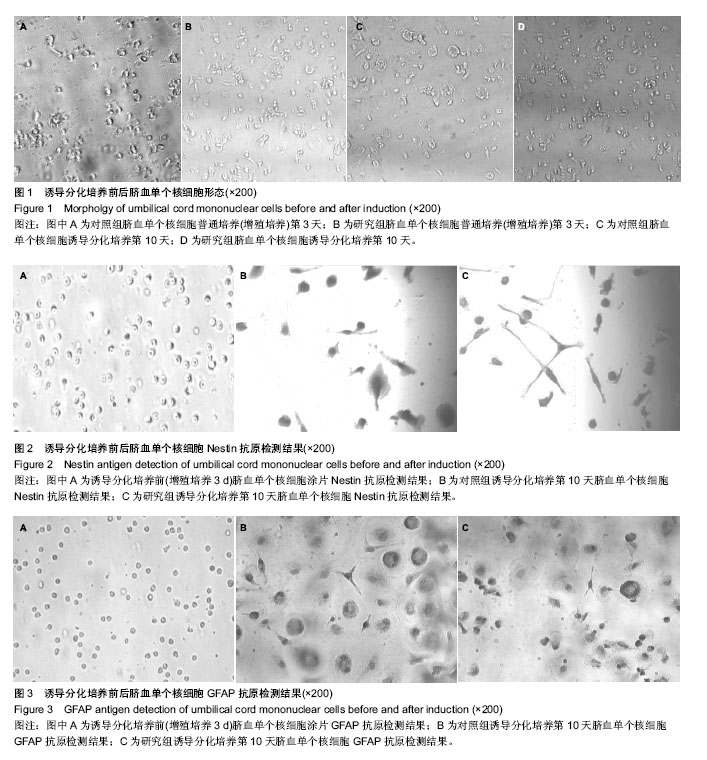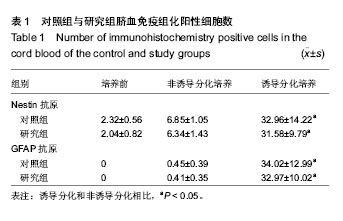| [1] Park KI. Transplantation of neural stem cells: cellular & genetherapy for hypoxic-ischemic brain injury. Yonsei Med J. 2000; 41:825-835.
[2] 栾佐,尹国才,胡晓红,等.人神经干细胞移植治疗重度新生儿缺氧缺血性脑病一例[J].中华儿科杂志, 2005,43(8): 580-583.
[3] 屈素清,栾佐,尹国才,等.新生鼠缺氧缺血性脑损伤后经脑室人神经干细胞移植的实验研究[J].中华儿科杂志,2005,43(8): 576-579.
[4] 屈素清,栾佐,尹国才,等.新生鼠缺氧缺血性脑损伤后内源性神经干细胞的增殖及迁移[J].中华小儿外科杂志,2005,26(5): 260-263.
[5] 栾佐.新生动物及其缺血性脑损伤神经干细胞移植的研究现状[J].中华儿科杂志,2004,42(4):305-307.
[6] Lee MW, Choi J, Yang MS,et al. Mesenchymal stem cells from cryopreserved human umbilical cord blood. Biochem Biophys Res Commun. 2004;320(1):273-278.
[7] 杜江榕,谢君辉,张军宏,等.人脐带血采集数量和质量的影响因素研究[J].吉林医学, 2007, 28(5): 641-642.
[8] Bieback K, Kern S, Klüter H,et al. Critical parameters for the isolation of mesenchymal stem cells from umbilical cord blood. Stem Cells. 2004;22(4):625-634.
[9] Reynolds BA, Weiss S.Generation of neurons and astrocytes from isolated cells of the adult mammalian central nervous system.Science. 1992;255(5052):1707-1710.
[10] Buzańska L, Machaj EK, Zab?ocka B,et al.Human cord blood-derived cells attain neuronal and glial features in vitro.J Cell Sci. 2002;115(Pt 10):2131-2138.
[11] 许遵鹏,廖灿,刘斌,等.脐血库建立中脐血筛选标准的制定及意义[J].中华器官移植杂志,2001,22(6):342-344.
[12] Shibata M, Kato T, Awaya T,et aChronic immune-mediated axonal polyneuropathy following umbilical cord blood transplant for childhood-onset cerebral adrenoleukodystrophy.Pediatr Transplant. 2012;16(8):E388-391.
[13] Gärtner A, Pereira T, Alves MG,et al.Use of poly(DL-lactide-ε-caprolactone) membranes and mesenchymal stem cells from the Wharton's jelly of the umbilical cord for promoting nerve regeneration in axonotmesis: in vitro and in vivo analysis.Differentiation. 2012;84(5):355-365.
[14] Taguchi A, Soma T, Tanaka H,et al.Administration of CD34+ cells after stroke enhances neurogenesis via angiogenesis in a mouse model.J Clin Invest. 2004;114(3):330-338.
[15] Atanassova V, Atanassova M, Nikolov A,et al.Influence of obstetric factors on the quality of cord blood units collected for allogeneic transplantation.Akush Ginekol (Sofiia). 2012;51(2): 11-16.
[16] 杜冀晖,张鲍虎,李蓉,等.人脐血干细胞蛛网膜下腔移植向神经干细胞分化的初步研究[J].国际检验医学杂志,2008,29(8): 676-678.
[17] 李静,王春芳,王晓霞,等.人脐血间充质干细胞诱导分化为神经细胞的研究[J].中国组织化学与细胞化学杂志,2007,16(6):625- 630.
[18] 王磊.脐血间充质干细胞定向诱导分化为神经细胞的研究进展[J].中国微侵袭神经外科杂志,2013,18(7):334-336.
[19] 潘丽杰,陈妍,袁杰,等.脐血间充质干细胞的分离培养鉴定及诱导分化研究[J].中国美容医学,2013,22(7):735-738.
[20] 武晓华,陈乃耀.人脐血间充质干细胞向多巴胺能神经元分化的体外诱导[J].中国组织工程研究,2012,16(49):186-19.
[21] 陈镭,陈冰,谢福堂.诱导脐血间充质干细胞向神经元样细胞分化[J].中国组织工程研究,2012,16(23):4335-4338.
[22] 赵迪诚,杜鹃,陈红,等.脐血间充质干细胞诱导向神经元样细胞分化的实验研究[J].现代生物医学进展,2011,11(24):4837-4840.
[23] 喻永涛,姜志峰,冯素银,等.人脐血间质干细胞向神经元样细胞诱导分化促进大鼠脊髓损伤神经恢复[J].江苏医药,2011,37(22): 2609-2612.
[24] 陈乃耀,张江,王大力,等.维甲酸联合脑源性神经生长因子体外诱导人脐血间充质干细胞向神经样细胞定向分化的实验研究[J].中国全科医学,2010,13(9):947-949.
[25] 黄伟,苗宗宁,陈镭,等.脑源性神经营养因子和睫状神经营养因子单独或联合体外诱导人脐带血来源的间充质干细胞向神经样细胞分化[J].中国组织工程研究与临床康复,2010,14(19):3606- 3610.
[26] 范亚珍,王军, 陈海,等.脐血单个核细胞体外向神经干细胞的诱导及Foxg1基因的表达[J].山东医药,2010,50(11):13-15.
[27] 王晓莉,赵岩松,李耀武,等.人脐血单个核细胞移植在缺氧缺血性脑损伤新生大鼠脑内的迁移及分化[J].中国组织工程研究与临床康复,2009,13(32):6259-6262.
[28] 李晓丰,侯萍,李革飞,等.人脐血单个核细胞体外定向诱导向神经干细胞分化[J].中国组织工程研究与临床康复,2008,12(51): 10142-10146.
[29] 向静,王昌铭,王景周.脐血单个核细胞体外定向分化为神经干细胞及其致瘤性的实验研究[J].中国医药导报,2007,4(26): 14-16,22.
[30] 徐虹,马希峰,阮丽荣,等.人脐血间充质干细胞体外诱导分化为神经元样细胞[J].基础医学与临床,2007,27(3):298-301.
[31] Warwick RM, Barbara JA.Safety aspects of cord blood banking.Bone Marrow Transplant. 1998;21 Suppl 3:S40-42.
[32] McGuckin CP, Forraz N, Allouard Q,et al.Umbilical cord blood stem cells can expand hematopoietic and neuroglial progenitors in vitro.Exp Cell Res. 2004;295(2):350-359.
[33] 徐蓉,刘波,段答,等.脐血单个核细胞移植治疗痉挛型小儿脑性瘫痪的安全性[J].中国组织工程研究,2012,16(41):7787-7790.
[34] 杜玲,杨华强,王娜,等.脐血间充质干细胞移植治疗儿童型脊肌萎缩症1例[J].中国组织工程研究与临床康复,2011,15(36): 6837-6840.
[35] 杨万章,吴芳,张敏,等.脐血源神经干细胞移植治疗神经系统疾病临床总结和分析[J].中西医结合心脑血管病杂志,2009,7(3): 287-290.
[36] 吴芳,杨佳勇,张敏,等.脐血间充质干细胞移植对脑性瘫痪儿童神经系统功能的影响:20例分析[J].中国组织工程研究与临床康复, 2008,12(16):3198-3200.
[37] 王利培,姜红.人脐血干细胞向神经细胞定向诱导及移植治疗大鼠缺氧缺血性脑损伤[J].中国组织工程研究与临床康复,2007, 11(7):1317-1320.
[38] 周毅,王景周.神经系统疾病中应用人脐血细胞对损伤的修复作用[J].中国临床康复,2005,9(9):153-155.
[39] 尚凤伟,王军,侯艳艳,等.神经干细胞移植对缺氧缺血性脑损伤新生大鼠脑组织Foxg1基因表达的影响[J].中华物理医学与康复杂志,2013,35(5):337-341.
[40] 颜小华,余珍,刘伟,等.脐血间充质干细胞移植修复缺氧缺血损伤新生大鼠的脑功能[J].中国组织工程研究,2012,16(45): 8445- 8452.
[41] 朱登纳,张博爱,王军,等.脐血源性神经干细胞移植对缺血缺氧性脑损伤新生大鼠的治疗作用[J].江苏医药,2010,36(24):2932- 2934.
[42] Fan CG, Zhang QJ, Tang FW,et al. Human umbilical cord blood cells express neurotrophic factors.Neurosci Lett. 2005; 380(3):322-325.
[43] Lee OK, Kuo TK, Chen WM,et al. Isolation of multipotent mesenchymal stem cells from umbilical cord blood.Blood. 2004;103(5):1669-1675.
[44] Lendahl U, Zimmerman LB, McKay RD.CNS stem cells express a new class of intermediate filament protein.Cell. 1990;60(4):585-595.
[45] Reynolds BA, Weiss S.Generation of neurons and astrocytes from isolated cells of the adult mammalian central nervous system.Science. 1992;255(5052):1707-1710.
[46] Buzańska L, Machaj EK, Zab?ocka B,et al.Human cord blood-derived cells attain neuronal and glial features in vitro.J Cell Sci. 2002;115(Pt 10):2131-2138.
[47] Bieback K, Kern S, Klüter H,et al.Critical parameters for the isolation of mesenchymal stem cells from umbilical cord blood.Stem Cells. 2004;22(4):625-634.
[48] 周毅,王景周,周萍,等.人脐血单个核细胞中Nestin阳性细胞表达及其临床意义[J].第三军医大学学报,2005,27(8):773-775.
[49] Jacobs VR, Niemeyer M, Gottschalk N,et al.Private umbilical cord blood banking does not reduce the number of samples for scientific stem cell research.Z Geburtshilfe Neonatol. 2005;209(6):223-227.
[50] Brazelton TR, Rossi FM, Keshet GI,et al.From marrow to brain: expression of neuronal phenotypes in adult mice. Science. 2000;290(5497):1775-1779. |


.jpg)